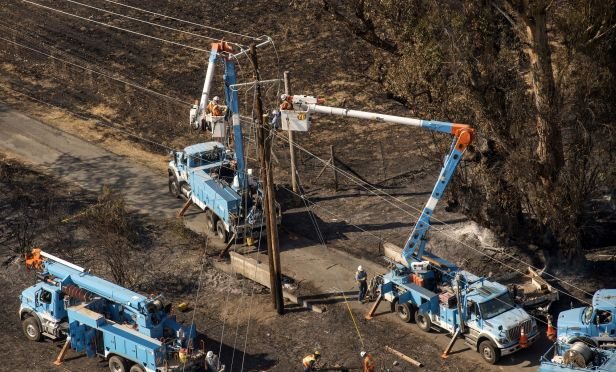 Pacific Gas & Electric Co. (PG&E) employees work to fix downed power lines burned by wildfires in this aerial photograph taken above Santa Rosa, California, on Thursday, Oct. 12, 2017. (Photo: David Paul Morris/Bloomberg)
Pacific Gas & Electric Co. (PG&E) employees work to fix downed power lines burned by wildfires in this aerial photograph taken above Santa Rosa, California, on Thursday, Oct. 12, 2017. (Photo: David Paul Morris/Bloomberg)
The lights would stay on if California utility giant PG&E Corp. files for bankruptcy. But the company, its customers and investors would be set for years of uncertainty.
While utility bankruptcies are rare, they can result in anything from a healthy company to a breakup, with business units sold off like spare parts. For consumers, the fallout likely means higher rates.
|Liabilities estimated by be as high as $30 billion
PG&E plunged 22% Monday on news that it's exploring a bankruptcy filing in response to an onslaught of wildfire liabilities that are estimated to be as high as $30 billion — far exceeding the company's market value of less than $10 billion.
Recommended For You
Want to continue reading?
Become a Free PropertyCasualty360 Digital Reader
Your access to unlimited PropertyCasualty360 content isn’t changing.
Once you are an ALM digital member, you’ll receive:
- Breaking insurance news and analysis, on-site and via our newsletters and custom alerts
- Weekly Insurance Speak podcast featuring exclusive interviews with industry leaders
- Educational webcasts, white papers, and ebooks from industry thought leaders
- Critical converage of the employee benefits and financial advisory markets on our other ALM sites, BenefitsPRO and ThinkAdvisor
Already have an account? Sign In Now
© 2025 ALM Global, LLC, All Rights Reserved. Request academic re-use from www.copyright.com. All other uses, submit a request to [email protected]. For more information visit Asset & Logo Licensing.








